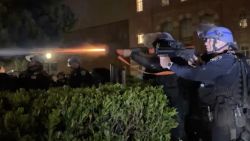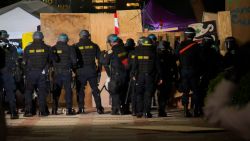Amid a rescue mission now in its fifth day, engineers and government officials are trying to determine how a Surfside, Florida, condominium tower crashed to the ground, seemingly without warning.
There are no clear answers yet, but early signs point to some failure in the lower reaches of the 13-story building, perhaps in its foundation, columns or underground parking garage.
Forensic engineers will need to examine the ground-floor columns in their investigation, said Sinisa Kolar, a Miami-based engineering executive.
“The key element to this investigation, in my opinion, lies in that rubble, in those columns and condition of the structural elements,” Kolar said.
The notion that the building collapsed due to a failure at or near its base seems to be supported by a report that Michael Stratton was on the phone with his wife, Cassondra, who told him their building was shaking just before the collapse. She was looking out from a condo at Champlain Towers South when she told him she saw “a sinkhole where the pool out her window used to be,” he told the Miami Herald.
The phone call then cut off. Stratton is among the scores of people who remain unaccounted for days after the collapse. The death toll stands at 11.
Allyn Kilsheimer, the structural engineer hired by the town of Surfside to look into the reasons for the collapse, said his investigation could last a few months or longer but there was no definitive timeline.
He said he has started to examine the building and will use a meticulous, computer-assisted process of elimination to attempt to identify the cause or causes.
“Unless it’s a plane or a bomb that you know triggered this whole thing, sometimes you can’t get it down to one cause,” he explained. “Sometimes… we don’t have enough information to decide between X, Y and Z, so it’s some combination of X, Y and Z,” he said. “But you don’t know what you’re going to end up with until you finish the whole study.”
Signs point to the building’s base
Engineers who have reviewed the available information about the tower’s collapse say the investigation into its cause should focus on potential failures near the base of the building.
Kolar expects investigators will test samples of concrete and examine its condition as part of the probe into what caused the collapse and cross-reference that with structural drawings.
The disaster most likely resulted from a combination of foundational and structural problems, said Mehrdad Sasani, a professor of civil and environmental engineering at Northeastern University.
The collapse likely started at lower floors of the condo and could have been influenced by “40 years of exposure to salt, water and salt air and the indication of some level of damage in the garage at the lower floors of the building.”
A range of other factors could have contributed to foundation and structural failures, including vibrations from recent construction work, heavy equipment on its roof and water damage associated with the building’s pool, Sasani said.
Joel Figueroa-Vallines, president of SEP Engineers, said he thinks it’s too early to reach conclusions, though video of the collapse appears to show that once the “pancaking” collapse began, columns at the center part of the building seemed to fail and a leaning effect occurred, followed by another part of the building falling.
All of the current analysis is speculative, he said, but added that speculation “is leaning toward to the fact that this did not topple over. This sort of came straight down.”
Figueroa-Vallines said he would focus an investigation on the foundation and the “podium level” of the pool deck. He also said he would look at the construction.
“Typically, with pancake construction, there isn’t a lot of redundancy in the floor system,” he said. “Flat slab systems generally have a little less redundancy – not that that is the cause of the collapse, but once that collapse is initiated, that system will accelerate with gravity.”
He cautioned, however: “Typically, in these cases there will not be what we call a definitive smoking gun; it’s more of a contributing factor scenario.”
Footage from the collapse shows a center section of the building crumble to the ground, before the easternmost portion of the building falls seconds later. Donald Dusenberry, a consulting engineer who has investigated structural collapses, told the newspaper it appeared to be “a foundation-related matter – potentially corrosion or other damage at a lower level,” though he did not rule out design or construction errors.
Peter Dyga, president and CEO of a Florida chapter of Associated Builders and Contractors, told CNN he’d begin any investigation in the middle portion of the wing that collapsed first.
“I’ve also seen some videos looking at the side of the building that’s still standing where it appears like the ground is creviced,” he said.
The failure may be in the support mechanism, said Kit Miyamoto, a structural engineer and California Seismic Safety Commission chairman.
“This collapse is a classic column failure, which means the building itself was supported by a series of pillars. If the pillars fail, everything fails,” Miyamoto said.
The building’s proximity to the Atlantic Ocean, with its corrosive seawater, increases the chances for spalling, wherein reinforced steel within the concrete begins to rust, said Miyamoto and Greg Batista, a specialist in concrete repair projects.
“I’ve seen up and down the coast hundreds of buildings where you have concrete problems,” Batista said. “If not maintained, whether it’s a concrete problem or a settling problem – it could be a bridge, it could be a building, it could be a dam or a sea wall – these kind of things happen if not tended to.”
A report and a lawsuit cited cracks
A 2018 report, which Surfside has released among other public records, noted problems with the building’s concrete, but an engineer who inspected Champlain Towers South last year said the report mentioned nothing alarming.
“Abundant cracking and spalling of various degrees was observed in the concrete columns, beams and walls,” the survey found. “Several sizeable spalls were noted in both the topside of the entrance drive ramp and underside of the pool/entrance drive/planter slabs, which included instances with exposed, deteriorating rebar. Though some of this damage is minor, most of the concrete deterioration needs to be repaired in a timely fashion.”
The waterproofing below the pool deck and entrance drive was failing and causing “major structural damage,” according to the report by Morabito Consultants.
The report didn’t indicate the structure was at risk of collapse.
Morabito Consultants “provided the condominium association with an estimate of the probable costs to make the extensive and necessary repairs. Among other things, our report detailed significant cracks and breaks in the concrete, which required repairs to ensure the safety of the residents and the public,” it said in a statement.
Condo owners in Champlain Towers South were facing assessments for $15 million worth of repairs – with payments set to begin just days after the building’s deadly collapse.
The building’s association approved a $15 million assessment in April to complete repairs required under the county’s 40-year recertification process, according to documents obtained by CNN. The deadline to pay upfront or choose a monthly fee lasting 15 years was July 1, a document sent to the owners said.
An itemized list of planned repairs included new pavers, planter landscape and waterproofing – addressing some of the issues noted in the 2018 report.
The most costly project listed was “facade, balcony and railing repairs” for $3.4 million.
In 2015, attorney Daniel Wagner filled a lawsuit alleging “cracks in the outside wall of the building” had allowed water into one of the condominiums. The case was settled.
Still, the issues flagged in the 2018 report would not be sufficient to cause a collapse, Kolar said he believes.

“When somebody shows us damages and corrosion and exposed rebar on the underside of the balcony, that’s a horizontal element that basically supports only that floor. So, if there is a collapse of a balcony, that most likely would not cause any additional damage to the rest of the building except for that particular balcony.
“Some of these damages as depicted in 2018 report – although problematic and definitely should have been addressed – in my opinion were unlikely to cause the collapse of the entire building,” he said. “It’s a giant leap from the damage depicted in that report to the collapse of the building and there are a bunch of dots missing to connect the two.”
Gregg Schlesinger, a Fort Lauderdale, Florida-based contractor and attorney who focuses on construction design, is one of several experts who say myriad factors might have played a role in the disaster.
“Did the building fail structurally? Yes. What makes up the structure? Concrete and steel. Did that fail? Yes. Why did it fail? … It was compromised,” he said. “What portions were compromised? In the pictures (in the 2018 report), we definitely see a column that’s structurally compromised.”
Other likely contributing causes: seismic loads from construction next door, which could degrade the structural capacity; as well as roof loading, which may have involved a “point load,” where equipment wasn’t scattered but was a dead load of equipment in one area that adds forces down through a compromised column. Also, the building is settling – the ground is settling and that could add additional forces to a compromised structure, he said.
“Each one of these items is a straw. It’s a piece of evidence. It’s a clue. Can I say, ‘Well it was 23.3% responsible? No,” Schlesinger said. “You know who will make that determination? Jurors. There will be, what I expect, a couple monthslong trial.”
Nothing alarming on the roof, an engineer says
Jason Borden, a structural engineer who examined the 40-year-old building last year, saw cracks in the facade and plaza level. While he was on site only for an hour, “what I did see while I was there did not alarm me at all,” he told CNN on Monday.
The 2018 report’s conclusions were “very typical of what we see in buildings of this age and condition,” he said.
The building was amid a milestone safety certification and was undergoing work on its concrete roof. Had the failure begun on the roof, Borden said, the collapse “would have looked very different.” If, as suspected, the collapse began somewhere in the bottom of the building, it’s likely something compromised a support column, he said.
Perhaps a slab fell and hit the column or a column’s braces failed or shifted, Borden speculated.
Several other experts have suggested a combination of factors could be behind the collapse.
“Usually it’s like a perfect storm,” said Atorod Azizinamini, a structural engineering professor at Florida International University.
A month after the report citing “major structural damage” was released, Rosendo Prieto, the Surfside building official at the time, told the building’s condo association that the tower was in “very good shape,” according to minutes from the November 15, 2018, meeting.
Two days before that meeting, a member of the condo board forwarded Prieto a copy of the October 2018 report, according to an email released by Surfside on Saturday.
The report’s findings were alarming, said Abieyuwa Aghayere, a Drexel University professor of structural engineering who reviewed the report. The findings should have spurred further review of the building’s integrity, the professor told CNN.
“Structural engineer report was reviewed by Mr. Prieto,” the meeting minutes state. “It appears the building is in very good shape.”
Condo resident Susana Alvarez recalled a Surfside representative say at the meeting, “The building was not in bad shape,” she told NPR.
Prieto now works for CAP Government Inc., to which CNN has reached out for comment. Prieto has not responded to requests for comment. CAP Government on Monday told officials in Doral, for which the company provides building inspection services, that Prieto is on a leave of absence, according to the city.
The building was sinking at one point
Another report that emerged last week indicates the condo tower – unlike surrounding structures – was sinking at a rate of 2 millimeters per year between 1993 and 1999. It’s unclear if the building continued to sink at that rate following the study.
More information is needed before determining if the sinking played a role in last week’s collapse, said Shimon Wdowinski, a coauthor of the study and professor with Florida International University’s Institute of Environment.
“If everything moves downward at the same level, then not so much,” he told CNN, but “if one part of the building moves with respect to the other, that could cause some tension and cracks.”
Residents would’ve noticed if the building’s “settlement” was uneven, Kobi Karp, a member of the American Institute of Architects, said last week. They would’ve seen cracks in their floors, walls and ceilings.
“The table would not be flat. Things would roll off,” he said.
It’s unclear if complaints of that nature were lodged with the tower’s management.
Buildings in nearby western Miami Beach, which was built on reclaimed wetlands, were moving at higher rates, “so we didn’t think it was something unusual,” Wdowinski said.
The building had undergone a series of inspections as part of its 40-year certification – a stringent process for updates and improvements enacted after Hurricane Andrew in 1992. The only recent repairs had been to the roof, said Kenneth Direktor, an attorney for the condominium association.
“Nothing like this was foreseeable,” Direktor said. “At least it wasn’t seen by the engineers who were looking at the building from a structural perspective.”
Surfside Mayor Charles Burkett has echoed that assertion, saying, “There’s no reason for this building to go down like that unless someone literally pulls out the supports from underneath, or they get washed out, or there’s a sinkhole or something like that.”
Surfside building official Jim McGuinness was on the roof 14 hours before the building collapsed and saw nothing unusual, he said. The building’s ongoing roofing permit was going well, he said.
“I have two words for the cause of this: under investigation,” McGuinness said.
CNN’s Casey Tolan, Rosa Flores, Eliott C. McLaughlin, Gregory Lemos and Gregory Krieg contributed to this report.























